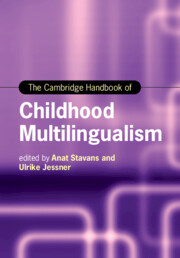Book contents
- The Cambridge Handbook of Childhood Multilingualism
- Cambridge Handbooks in Language and Linguistics
- The Cambridge Handbook of Childhood Multilingualism
- Copyright page
- Contents
- Figures
- Tables
- About the Editors
- Contributors
- Acknowledgments
- Multilingualism Is Not Bilingualism +1: An Introduction
- Part One Becoming and Being a Multilingual Child
- Part Two Cognition and Faculties in Multilinguals
- Part Three Family Language Policy
- Part Four Language(s) and Literacy of Multilingual Children through Schooling
- 15 Being Plurilingual in the Language Classroom
- 16 Literacy Development in the Multilingual Child: From Speaking to Writing
- 17 Attitudes, Motivations, and Enjoyment of Reading in Multiple Languages
- 18 Growing Up with Multilingual Literacies and Implications for Spelling
- 19 Assessing Multilinguals
- 20 Plurilingualism and Young Children’s Perspectival Cognition
- Part Five Socialization in Childhood Multilingualism
- Part Six Multilingual Children’s Landscape
- Subject Index
- Country Index
- Language Index
- References
20 - Plurilingualism and Young Children’s Perspectival Cognition
from Part Four - Language(s) and Literacy of Multilingual Children through Schooling
Published online by Cambridge University Press: 18 August 2022
- The Cambridge Handbook of Childhood Multilingualism
- Cambridge Handbooks in Language and Linguistics
- The Cambridge Handbook of Childhood Multilingualism
- Copyright page
- Contents
- Figures
- Tables
- About the Editors
- Contributors
- Acknowledgments
- Multilingualism Is Not Bilingualism +1: An Introduction
- Part One Becoming and Being a Multilingual Child
- Part Two Cognition and Faculties in Multilinguals
- Part Three Family Language Policy
- Part Four Language(s) and Literacy of Multilingual Children through Schooling
- 15 Being Plurilingual in the Language Classroom
- 16 Literacy Development in the Multilingual Child: From Speaking to Writing
- 17 Attitudes, Motivations, and Enjoyment of Reading in Multiple Languages
- 18 Growing Up with Multilingual Literacies and Implications for Spelling
- 19 Assessing Multilinguals
- 20 Plurilingualism and Young Children’s Perspectival Cognition
- Part Five Socialization in Childhood Multilingualism
- Part Six Multilingual Children’s Landscape
- Subject Index
- Country Index
- Language Index
- References
Summary
The chapter explores how plurilingualism potentially influences young children's perspectival cognition, including understandings of false belief and implications for cooperative science inquiry.
Keywords
- Type
- Chapter
- Information
- The Cambridge Handbook of Childhood Multilingualism , pp. 472 - 488Publisher: Cambridge University PressPrint publication year: 2022
References
- 1
- Cited by

